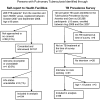Risk factors for inadequate TB case finding in Rural Western Kenya: a comparison of actively and passively identified TB patients
- PMID: 23634206
- PMCID: PMC3636249
- DOI: 10.1371/journal.pone.0061162
Risk factors for inadequate TB case finding in Rural Western Kenya: a comparison of actively and passively identified TB patients
Abstract
Background: The findings of a prevalence survey conducted in western Kenya, in a population with 14.9% HIV prevalence suggested inadequate case finding. We found a high burden of infectious and largely undiagnosed pulmonary tuberculosis (PTB), that a quarter of the prevalent cases had not yet sought care, and a low case detection rate.
Objective and methods: We aimed to identify factors associated with inadequate case finding among adults with PTB in this population by comparing characteristics of 194 PTB patients diagnosed in a health facility after self-report, i.e., through passive case detection, with 88 patients identified through active case detection during the prevalence survey. We examined associations between method of case detection and patient characteristics, including HIV-status, socio-demographic variables and disease severity in univariable and multivariable logistic regression analyses.
Findings: HIV-infection was associated with faster passive case detection in univariable analysis (crude OR 3.5, 95% confidence interval (CI) 2.0-5.9), but in multivariable logistic regression this was largely explained by the presence of cough, illness and clinically diagnosed smear-negative TB (adjusted OR (aOR) HIV 1.8, 95% CI 0.85-3.7). Among the HIV-uninfected passive case detection was less successful in older patients aOR 0.76, 95%CI 0.60-0.97 per 10 years increase), and women (aOR 0.27, 95%CI 0.10-0.73). Reported current or past alcohol use reduced passive case detection in both groups (0.42, 95% CI 0.23-0.79). Among smear-positive patients median durations of cough were 4.0 and 6.9 months in HIV-infected and uninfected patients, respectively.
Conclusion: HIV-uninfected patients with infectious TB who were older, female, relatively less ill, or had a cough of a shorter duration were less likely found through passive case detection. In addition to intensified case finding in HIV-infected persons, increasing the suspicion of TB among HIV-uninfected women and the elderly are needed to improve TB case detection in Kenya.
Conflict of interest statement
Figures

Similar articles
-
High prevalence of pulmonary tuberculosis and inadequate case finding in rural western Kenya.Am J Respir Crit Care Med. 2011 May 1;183(9):1245-53. doi: 10.1164/rccm.201008-1269OC. Epub 2011 Jan 14. Am J Respir Crit Care Med. 2011. PMID: 21239690
-
Tuberculosis case finding using population-based disease surveillance platforms in urban and rural Kenya.BMC Infect Dis. 2018 Jun 7;18(1):262. doi: 10.1186/s12879-018-3172-z. BMC Infect Dis. 2018. PMID: 29879917 Free PMC article.
-
Tuberculosis Case Finding in HIV-Infected Pregnant Women in Kenya Reveals Poor Performance of Symptom Screening and Rapid Diagnostic Tests.J Acquir Immune Defic Syndr. 2016 Feb 1;71(2):219-27. doi: 10.1097/QAI.0000000000000826. J Acquir Immune Defic Syndr. 2016. PMID: 26334736 Free PMC article.
-
A survey on undiagnosed active pulmonary tuberculosis among pregnant mothers in mekelle and surrounding Districts in Tigray, Ethiopia.Int J Mycobacteriol. 2017 Jan-Mar;6(1):43-46. doi: 10.4103/2212-5531.201889. Int J Mycobacteriol. 2017. PMID: 28317804 Free PMC article.
-
Risk factors associated with 1-year mortality among patients with HIV-associated tuberculosis in areas with intermediate tuberculosis burden and low HIV prevalence.Hong Kong Med J. 2018 Oct;24(5):473-483. doi: 10.12809/hkmj187303. Hong Kong Med J. 2018. PMID: 30262675 Review.
Cited by
-
Pulmonary Tuberculosis Infectiousness of Persons Identified Through Active and Passive Case-finding in a High-burden Setting.Open Forum Infect Dis. 2025 Feb 10;12(3):ofaf077. doi: 10.1093/ofid/ofaf077. eCollection 2025 Mar. Open Forum Infect Dis. 2025. PMID: 40046891 Free PMC article.
-
A comparison between passive and active case finding in TB control in the Arkhangelsk region.Int J Circumpolar Health. 2014 Feb 14;73:23515. doi: 10.3402/ijch.v73.23515. eCollection 2014. Int J Circumpolar Health. 2014. PMID: 24563859 Free PMC article.
-
Factors associated with interruption of tuberculosis treatment among patients in Nandi County, Kenya 2015.Pan Afr Med J. 2017 Nov 6;28(Suppl 1):11. doi: 10.11604/pamj.supp.2017.28.1.9347. eCollection 2017. Pan Afr Med J. 2017. PMID: 30167036 Free PMC article.
-
Symptom- and chest-radiography screening for active pulmonary tuberculosis in HIV-negative adults and adults with unknown HIV status.Cochrane Database Syst Rev. 2022 Mar 23;3(3):CD010890. doi: 10.1002/14651858.CD010890.pub2. Cochrane Database Syst Rev. 2022. PMID: 35320584 Free PMC article.
-
Coverage of clinic-based TB screening in South Africa may be low in key risk groups.Public Health Action. 2016 Mar 21;6(1):19-21. doi: 10.5588/pha.15.0064. Epub 2015 Jan 25. Public Health Action. 2016. PMID: 27051606 Free PMC article.
References
-
- World Health Organization (2010) Global tuberculosis control: WHO report 2010. Geneva: World Health Organization (WHO/HTM/TB/2010.7); 2010.
-
- Santha T, Renu G, Frieden TR, Subramani R, Gopi PG, et al. (2003) Are community surveys to detect tuberculosis in high prevalence areas useful? Results of a comparative study from Tiruvallur District, South India. Int J Tuberc Lung Dis. 2003 7(3): 258–65. - PubMed
Publication types
MeSH terms
Grants and funding
LinkOut - more resources
Full Text Sources
Other Literature Sources
Medical
Molecular Biology Databases
Miscellaneous

